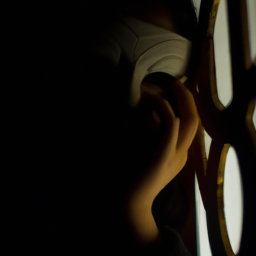While laying in bed, my mind drifts into a world where anything is possible. My dreams take me on exciting adventures, introducing me to new people and evoking a range of emotions.
But have you ever wondered what kinds of dreams there are? The world of dreams is vast and intricate, and there are several types of dreams that people experience.
From lucid dreams to nightmares, the different kinds of dreams offer a unique insight into our subconscious. Understanding the science behind dreaming and the interpretation of dreams can help us gain a deeper understanding of ourselves and our emotions.
In this article, we will explore the different types of dreams, techniques for lucid dreaming, overcoming nightmares, and the emotional connection to our dreams.
So sit back, relax, and let’s dive into the mysterious world of dreams.
Key Takeaways
- There are two main types of dreams: lucid dreams and nightmares.
- Dreams reveal desires, fears, and anxieties and can help solve problems and serve physiological function.
- Interpreting dreams involves analyzing symbols and themes to identify personal meanings.
- Seeking professional help may be beneficial for understanding and processing dream content.
Types of Dreams
There’s a wide variety of dreams out there, from the mundane to the downright bizarre. Some dreams are simply a reflection of our everyday lives and experiences, while others are filled with fantastical creatures and surreal landscapes that seem to defy all logic.
Some dreams are happy and pleasant, while others are filled with fear or anxiety. One type of dream that is particularly interesting is the lucid dream. In a lucid dream, the dreamer is aware that they are dreaming and can sometimes control the content of the dream. It’s almost like a waking dream, where the dreamer can explore their own subconscious mind and interact with the dream in a way that is not possible in regular dreams.
But how do we dream in the first place?
Let’s explore the science of dreaming.
The Science of Dreaming
I find the science of dreaming fascinating, particularly when it comes to understanding the brain activity during sleep.
One of the key aspects of dreaming is the role of REM sleep, which is when we experience the most vivid and memorable dreams.
There are also various theories about the function of dreaming, which have been the subject of much debate and research.
I’m really interested in learning more about this topic and exploring the mysteries of the dreaming mind.
Brain Activity During Sleep
As I lay in bed, my brain activity during sleep increases and decreases in cycles, with different stages of sleep characterized by distinct patterns of brain waves. During the first stage of sleep, my brain waves start to slow down from the wakeful state, and the muscles begin to relax. In this stage, I may experience sudden muscle contractions that may make me feel like I’m falling. The second stage of sleep is characterized by a decrease in body temperature, heart rate, and breathing rate. Brain waves become larger and slower, and I spend most of my sleep in this stage. The third stage of sleep is considered the deep sleep stage, where the brain waves become even slower, and it becomes harder to wake up. This stage is crucial for physical restoration and repair.
To understand the different stages of sleep better, I’ve created a table below that highlights the changes in brain activity, muscle tone, eye movement, and dreaming during each sleep stage.
| Sleep Stage | Brain Waves | Muscle Tone | Eye Movement | Dreaming |
|---|---|---|---|---|
| Stage 1 | Alpha and Theta Waves | Relaxed | None | Hypnagogic Hallucinations |
| Stage 2 | Theta Waves with Sleep Spindles and K-Complexes | Decreased | None | None |
| Stage 3 | Delta Waves | Minimal | None | None |
As we move into the next section about the role of REM sleep, we’ll delve into the final stage of sleep, where dreaming occurs.
The Role of REM Sleep
Get ready to explore the fascinating world of REM sleep, where your brain becomes more active, your eyes move rapidly, and vivid dreams can occur. REM stands for Rapid Eye Movement, and it is one of the four stages of sleep that we experience.
During this stage, our brain activity increases, and our muscles become paralyzed, preventing us from acting out our dreams. REM sleep is essential for our overall health and wellbeing.
It’s believed to play a crucial role in memory consolidation, emotional regulation, and learning. Research has shown that people who are deprived of REM sleep have difficulty concentrating and are more prone to mood swings.
Now, let’s delve deeper into the theories of dream function and explore the different interpretations of why we dream.
Theories of Dream Function
You’re about to dive into the theories of dream function, where different interpretations are like branches on a tree, each one reaching towards a unique understanding of why we dream. One of the most popular theories is the psychoanalytic theory, which argues that dreams are a window into the unconscious mind and that they reveal our deepest desires, fears, and anxieties. According to this theory, dreams provide a safe space for us to explore and process our emotions, especially those that may be too difficult to confront in waking life.
Another theory is the problem-solving theory, which suggests that dreams help us solve complex problems by providing an opportunity for creative thinking and problem-solving. In this view, dreams are seen as a way for the brain to work through unresolved issues and find new solutions. Some researchers also propose that dreams may serve a physiological function, such as strengthening neural connections or helping to consolidate memories. While there is no one definitive answer to why we dream, these theories offer intriguing possibilities for what dreams may be trying to tell us.
As we explore the different theories of dream function, it’s important to consider the various ways in which we interpret dreams. While some people may see dreams as a way to access hidden truths or gain insight into their lives, others may view them as meaningless or random. Understanding our own personal interpretation of dreams can help us better understand the role they play in our lives and the insights they may offer.
The Interpretation of Dreams
When it comes to interpreting dreams, I find it helpful to analyze the symbols and themes present in the dream. This can often reveal deeper meanings and connections to our waking life.
Additionally, identifying personal meanings and associations with the symbols can provide insight into our subconscious thoughts and emotions. However, if the dream is particularly distressing or confusing, seeking professional help from a therapist or counselor can also be a valuable tool in understanding its significance.
Analyzing Symbols and Themes
Exploring the symbols and themes present in our dreams can unveil hidden emotions and subconscious thoughts. To begin with, dreams can have a variety of symbols, which can mean different things depending on the context of the dream.
For example, a snake can represent fear, danger, or transformation. Similarly, water can represent cleansing, emotional turmoil, or the unconscious. By analyzing the symbols present in our dreams, we can gain insight into our own psyche and understand our feelings and experiences better.
Moreover, themes in dreams can also serve as a window into our subconscious. Dreams can be categorized into various themes, such as falling, flying, being chased, or losing teeth. Each of these themes can signify different emotions or experiences.
For instance, falling dreams can indicate a lack of control or fear of failure, while flying dreams can suggest a sense of freedom or empowerment. Exploring the themes in our dreams can help us identify patterns in our thinking and provide clues to our deepest desires and fears.
By analyzing symbols and themes in our dreams, we can make sense of our subconscious thoughts and emotions. This can help us identify personal meanings that are unique to us and gain a better understanding of our own psyche.
Identifying Personal Meanings
Identifying personal meanings in our dreams can be an eye-opening experience, as it allows us to uncover hidden aspects of ourselves. Dreams are highly personal and unique to each individual. Therefore, it’s important to approach dream analysis with an open mind and a willingness to explore our innermost thoughts and feelings.
When we identify the personal meanings in our dreams, we can gain insight into our subconscious desires, fears, and motivations. For example, a dream about falling may represent a fear of failure or loss of control. By acknowledging and addressing these underlying emotions, we can begin to work through them and make positive changes in our waking lives.
However, if we find ourselves struggling to understand or cope with our dreams, seeking professional help may be beneficial in gaining a deeper understanding and finding ways to address any issues that arise.
Seeking Professional Help
If you are struggling to make sense of your dreams, it may be helpful to seek professional assistance to gain a deeper understanding and find ways to address any underlying issues. A therapist or counselor trained in dream analysis can help you explore the various symbols and themes in your dreams, and guide you in interpreting their meanings. They can also provide insight into any emotional or psychological issues that may be manifesting in your dreams, and offer strategies for coping with them.
When seeking professional help with your dreams, it’s important to find a therapist who is experienced in dream analysis and who you feel comfortable working with. You may also want to consider alternative forms of therapy, such as hypnotherapy or art therapy, which can help you access deeper levels of your subconscious mind. By working with a professional, you can gain a better understanding of your dreams and use this knowledge to make positive changes in your waking life.
Transition: While seeking professional help can be a great way to gain deeper insight into your dreams, another effective technique is keeping a dream journal.
Dream Journaling
Dream journaling is a fun and effective way to recall the vivid details of your dreams. By writing down everything you remember about your dreams, you can gain insight into your subconscious mind and learn more about yourself. Here are three reasons why dream journaling is worth trying:
-
It helps you remember your dreams more clearly. Writing down your dreams as soon as you wake up can help you remember more details than if you simply try to recall them from memory later on.
-
It can reveal patterns and themes in your dreams. By keeping track of your dreams over time, you may notice certain recurring themes or symbols that can help you understand your subconscious better.
-
It can be a therapeutic tool. Dream journaling can help you work through emotional issues and gain a deeper understanding of yourself and your needs.
Now that you know the benefits of dream journaling, you may be interested in exploring lucid dreaming techniques.
Lucid Dreaming Techniques
Lucid dreaming is an exciting way to explore the depths of your subconscious, and with the right techniques, you can experience vivid, life-like dreams that feel just as real as waking life. One technique to induce lucid dreaming is reality testing, which involves questioning if you are dreaming throughout the day. By doing this, you may notice inconsistencies in your surroundings or actions that indicate you are dreaming.
Another technique is visualization, where you imagine yourself becoming lucid in a dream and rehearse what you would do once you achieve lucidity. Additionally, keeping a dream journal and regularly recalling your dreams can help you recognize patterns and themes in your dreams, which can increase your chances of becoming lucid. Practice and patience are key when it comes to lucid dreaming, but the experience can be incredibly rewarding.
With lucid dreaming, you have the power to control your dreams and explore your subconscious, but there may be times when you encounter nightmares or unpleasant dream scenarios. In the next section, we will discuss ways to overcome these challenges and turn them into opportunities for growth and self-discovery.
Overcoming Nightmares
Confronting and overcoming nightmares can be a powerful tool for personal growth and understanding the deeper aspects of our psyche. Here are some tips that have helped me overcome my own nightmares:
-
Identify the fear: Try to understand what specifically is causing the fear in your nightmare. Is it a fear of failure, rejection, or something else? Once you’ve identified the fear, you can start working on overcoming it in your waking life.
-
Change the ending: When you wake up from a nightmare, take a few minutes to imagine a different ending. Visualize yourself conquering the fear and overcoming the obstacle in a positive way. This can help rewire your brain and reduce the likelihood of having the same nightmare again.
-
Practice relaxation techniques: Before going to bed, try practicing relaxation techniques like deep breathing, meditation, or yoga. This can help calm your mind and reduce the likelihood of having a nightmare.
-
Seek support: If you continue to have nightmares that are causing distress, consider talking to a therapist or trusted friend to help you work through the underlying issues.
By confronting and overcoming our nightmares, we can gain a better understanding of ourselves and our fears. This can lead to personal growth and a deeper appreciation for the power of our dreams.
In the next section, we’ll explore the benefits of dream sharing and analysis.
Dream Sharing and Analysis
After learning about how to overcome nightmares in the previous section, I want to explore another aspect of dreams – sharing and analyzing them. I have always been fascinated by the different types of dreams we have and what they might mean. I believe that dreams can reveal a lot about our subconscious thoughts and emotions, and that by analyzing them we can gain a deeper understanding of ourselves.
One way to explore our dreams is through dream sharing and analysis. This involves discussing our dreams with others and trying to interpret their meanings. There are different approaches to dream analysis, but one common technique is to identify the symbols and themes in the dream and relate them to our waking life. To give an example, I have created a table below that shows some common dream symbols and their possible interpretations.
| Symbol | Possible Interpretation |
|---|---|
| Flying | Feeling of freedom or escape |
| Teeth falling out | Anxiety or fear of losing power |
| Being chased | Feeling of being threatened or pursued |
| Water | Emotions or unconscious mind |
| Death | Endings or transformation |
Understanding the meaning of our dreams can be a valuable tool for personal growth and self-awareness. By exploring our dreams and the emotions they evoke, we can gain insight into our innermost thoughts and feelings. This can help us better understand our relationships, our goals, and our overall emotional health.
As we delve deeper into the connection between dreams and emotional health, we will explore how our dreams can impact our mental and physical wellbeing.
The Connection Between Dreams and Emotional Health
Exploring the link between our dreams and emotional wellbeing can provide valuable insight into our subconscious thoughts and help us better understand our overall mental and physical health.
Dreams can be a reflection of our deepest fears, hopes, desires, and experiences. They can also reveal unconscious emotions that we may not be aware of during our waking hours.
Analyzing our dreams can help us identify patterns and themes that may be impacting our emotional state, and provide us with an opportunity to address any underlying issues.
It’s important to note that dreams can have both positive and negative effects on our emotional health. While some dreams may bring up unpleasant emotions or memories, others can provide us with a sense of comfort and peace.
Understanding the connection between our dreams and our emotions can help us navigate the complex landscape of our subconscious and improve our overall wellbeing.
Frequently Asked Questions
How can I control the content of my dreams?
I can control the content of my dreams by practicing lucid dreaming techniques. This involves becoming aware that I am dreaming and then actively shaping the dream world around me. With practice, I can have more control over my dream experiences.
Can dreams predict the future?
Dreams can provide insights into our subconscious, but they do not predict the future. They are symbolic representations of our emotions, experiences, and memories, and can be influenced by our current thoughts and emotions.
Why do we forget our dreams so easily?
I forget my dreams easily because they aren’t stored in my long-term memory. Dreams occur during REM sleep, which doesn’t allow for the consolidation of memories. Also, our brains prioritize important memories over trivial ones.
Is dreaming only a human experience?
Oh, sure. Because animals can’t possibly have complex dreams like us humans do. I mean, who needs REM sleep anyway? Of course, dreaming is a uniquely human experience. eye roll
Can recurring dreams have a deeper meaning?
Recurring dreams can have a deeper meaning. They often represent unresolved emotions or issues in our waking lives. Paying attention to the details and themes can lead to personal growth and understanding.
Conclusion
Well, that’s a wrap, folks! I hope you enjoyed learning about the different types of dreams, the science behind dreaming, and how to interpret your own dreams.
Remember, keeping a dream journal and practicing lucid dreaming techniques can greatly enhance your dream experience and provide insight into your subconscious mind. And don’t forget about the connection between your dreams and emotional health – paying attention to your dreams can help you process and work through difficult emotions.
Overall, dreams are a fascinating and mysterious part of the human experience. As the famous rapper Vanilla Ice once said, "Dreams are like a box of chocolates, you never know what you’re gonna get."So, embrace the unknown, explore your dreams, and who knows – you may just unlock the secrets of your own mind.










